Combat Conditioning: The Foundations of Survival
Originally published in Counter Terrorist Magazine
By Bernardo C.
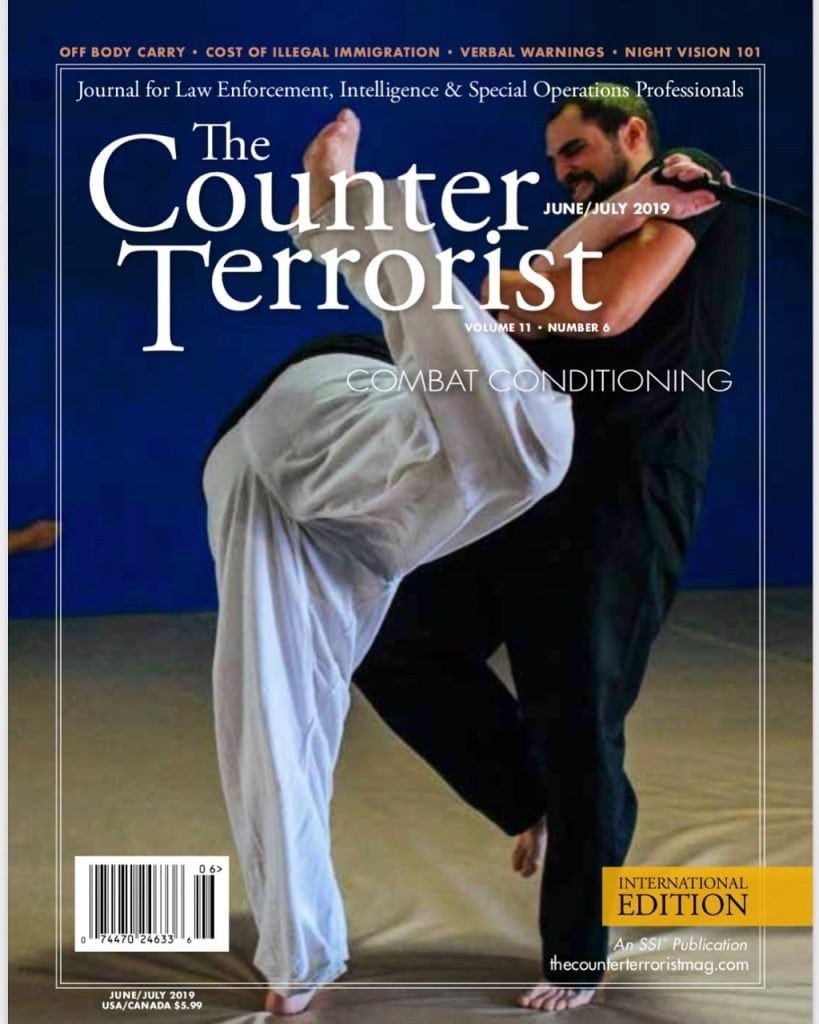
My friend Pavel was a trained boxer; he did not serve in the military. One night while drinking, two of our country’s finest decided to stab him for dancing with the wrong girl. While Pavel had no official self-defense or hand-to-hand combat training, he was able to survive this close encounter with two armed killers. How did he do that? Beyond pure luck and medical treatment, Pavel had a combat spirit and he was capable of delivering violence. Pavel did not react with any fancy defensive or deflective moves against the knife, nor did he employ any special tactics. He simply struck at them with punches while he was still standing, knocking one of them out immediately. Once Pavel fell to the floor, he did not use his legs for defensive kicking; he fished around with his hands for the nearest object that he could pick up and strike with. He found a tree branch and used it to strike at the remaining attacker, deterring him and prompting him to run away. My friend received dozens of stab wounds, but he lived to tell the tale.
What elements can influence our survival during a deadly hand-to-hand combat scenario?
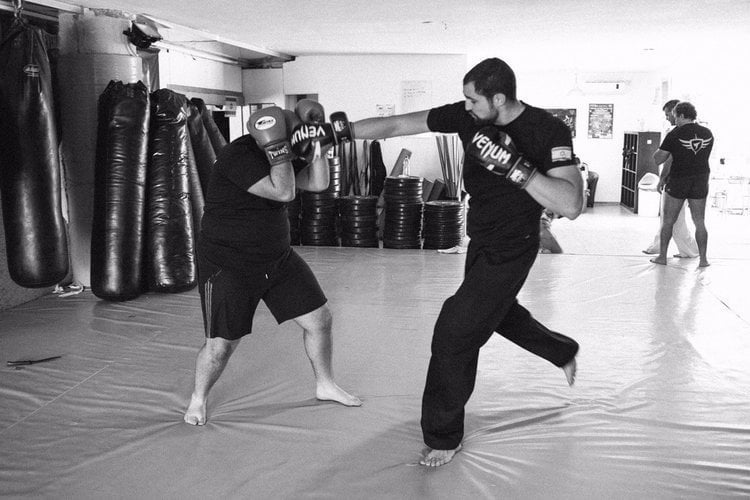
The main elements of survival are SPIRIT – MIND – BODY, in that order. Without a strong fighting SPIRIT and the will to survive, you probably won’t make it. You will freeze and let your attacker do whatever they want, and this will most likely result in more damage or complete neutralization. If you choose to fight, however, you stand a chance. Your MIND is your strongest weapon, and your internal dialogue and your mental ability will dictate your effectiveness. When strong, they allow you to identify and seize opportunities and follow concepts correctly under stress. Your BODY is the machine and you need to take care of it. You also need to train it to become dangerous and powerful. This is the difference between bringing an old French campaign cannon to a fight or a modern battle tank.

SPIRIT
“It’s not the size of the dog in the fight, it’s the size of the fight in the dog.” —Mark Twain
Have you ever seen a bird defend its nest? No matter the size of the predator, a bird will be extremely aggressive and transmit an extreme will to survive.
This aggressive instinct is natural to human beings as well. We developed it in order to hunt larger animals and defend ourselves from predators. However, we’ve learned over time to repress this instinct because this radical behavior is unacceptable in today’s society. Aggression is viewed as incompatible with being a normative citizen. In school, aggressive kids are punished. In the streets or at work, aggressive behavior does not get you far either. This is legitimate and it makes perfect sense in terms of keeping order in the world. In matters of life and death, however, aggression is key. We must learn to release the violent and aggressive animal that is hiding inside when needed.
Why is this aggressive impulse so important and how do we use it effectively?
Aggression is important because it serves first and foremost as a deterrent to attackers. Studies have shown that sexual predators choose easy targets over hard ones. We see this in professional contact sports as well. Some fighters “lose the fight” in their minds before they even enter the arena. Think about Mike Tyson’s deterrence and legendary mental intimidation tactics. In his prime, no one wanted to fight Mike Tyson, and those who did came into the ring knowing they were going to lose. When you develop a highly aggressive attitude, you become a very scary person who no one wants to mess with.
In addition to the valuable deterrence it gives, aggression is also a critical element in violence of action. A key component of special forces combat doctrine in the most dangerous and violent scenarios, violence of action means the unrestricted use of speed, strength, surprise, and aggression to dominate your adversary. This means you hit with bad intentions and overwhelm your opponent with killer speed and power, swift and deadly.
This violence of action begins by “turning on the switch”. As previously stated, we live in a zero aggression state of life, but we must accelerate our transition to aggression when presented with danger. One of the main lessons of military hand-to-hand combat is controlling this internal switch, and learning how to go from a zero level of aggression to a 100 level immediately. This is necessary because when you are on the defense, you start with a handicap. You are relaxed and distracted when the attacker surprises you at a 100 level of aggression and violence, and with complete physical and psychological readiness. Learning how to react immediately and reach a maximum level of violence quickly can mean the difference between life and death. There is no time to lose and you must wake up the beast in order to fight for your life—no warmups, no drills, just a cold start FIGHT.
All of this does not work if a strong will to survive is not present. It’s not over until it’s over, and you never ever ever quit, no matter what! Countless people have been put through incredible hardships and have managed to survive against all odds: policemen and military who continue to fight until their last breath; victims who escape life threatening scenarios even though they are injured, outnumbered, or out powered; people who have survived years of captivity. What all of these people have in common is a remarkable and unbreakable will to live, no matter the odds.
MIND
“Don’t depend on the enemy not coming; depend rather on being ready for him.” —Sun Tzu
This is perhaps the hardest concept to understand and develop into full mastery. The idea of prevention is one of the greatest foundations of security at any level. Personal, material, and elite dignitary protection success are all based upon the concept of prevention over reaction. Some of the main ideas of this concept are risk analysis, security and emergency planning, deterrence, deception, unpredictability, surveillance, and technology. At a professional level some applications of this concept could include writing an effective risk analysis and emergency response protocol for a company or infrastructure, selecting random routes of travel for a VIP or dignitary, employing undercover surveillance and protection assets, and positioning overt units and assets to produce deterrence upon the adversary.
Plan the safest route to a location.
Will passing through any neighborhood or area be a wise choice at any time of day or night and under any circumstances? In terms of protection and accountability, does anyone know that you are in the back of a taxi? Do you know the number and name of the driver? Send it to someone who will have your back and look for you or help you if things go wrong.
Protect your base camp.
How easily can someone break into your home? Have you set up a surveillance system? Have you set up effective prevention and emergency response protocols at home? Do you drill these concepts often with your family members?
Identify dangerous behavior or threats early.
You can be completely submerged in your smartphone looking for the latest Pokémon, or you can maintain peripheral awareness of what’s happening around you. Your level of awareness is a critical deterrent for any attacker. Investigations of both foiled and successful terror and criminal plots have shown that adversaries look for the weakest link—they choose a distracted guard or a policeman who is busy with his phone or food over the one who looks ready to put up a fight. Furthermore, in heavily crowded locations, being able to perceive individual treats or abnormal crowd behavior is key to reacting in time.
Choose your kit.
Choose the right clothing and tool system (i.e., functional soles over high heels, garments that allow quicker movement and deployment of weapons, and so on). If you carry a gun or pepper spray inside a handbag, will you be able to deploy it under pressure? Are you aware of the condition of your weapon? Do you know how to effectively and safely use your weapon?
Practice personal deterrence.
What is your personal deterrence level? Do you look dangerous? Are you focused or distracted? Do you look scared? Even if you are not a big person, your personal confidence and state of mind transfer into the desired body language and are reflected in the way you carry yourself.
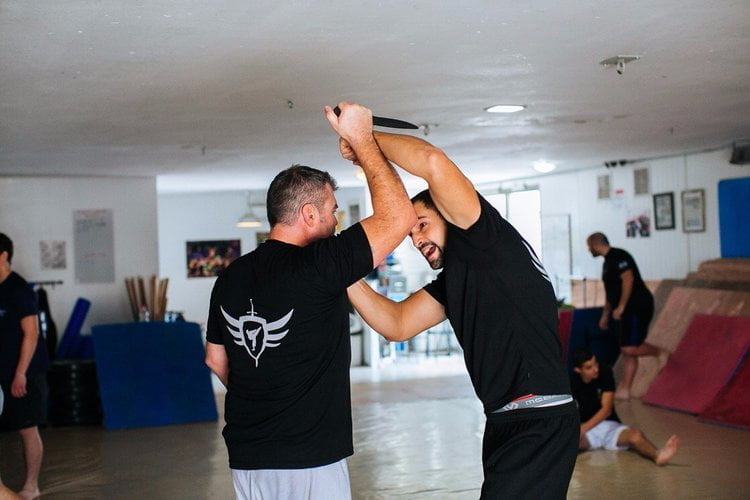
BODY
“The three most important things in a fighter are fitness, fitness, and more fitness.” —B.P.
Many years ago, one of my first coaches asked me, “What are the three most important things a good fighter needs?” I mentioned many sound qualities, but this did not satisfy him. He said, “Firstly, a good fighter needs superior fitness. Secondly, more fitness. And thirdly, fitness one more time.” You may not agree with this right now, but it is 100 percent accurate for professional fighters and very relevant for everyday people on the street as well.
For example, consider professional fighting organizations like the UFC. There are many skilled candidates with decades of martial arts experience dying to get a UFC contract. However, the UFC sometimes hires transitioning athletes from football or other professional sports, even though they have no fighting background. This decision—although odd and controversial—is based on sound judgement. These men have superb athleticism and an experienced professional athlete mentality; this allows them to compete at the highest level faster than others with better technique.
A strong body reflects deterrence and confidence. Being healthy and in shape allows you to reach higher levels of training and gives you additional benefits in your life as well. Training hard is also an exercise in mental toughness because it requires grit and determination to push yourself beyond your comfort zone. Moreover, a strong and fit person is usually a disciplined person, and discipline is a quality that leads to success at the highest levels.
I believe the optimal training regimen is the following:
- Train five or six days a week and rest one or two days.
- This includes martial arts, but does not include shooting or tactical unless you are doing something physically challenging there, too.
- Eat a low carb diet.
- Go for high protein and fat with as little carbohydrates as possible.
- Sleep six hours a day.
“If you need to sleep more, do it faster” –Arnold Schwarzenegger
Physical Training Prescription
- Run, swim, ruck, bicycle, or row at least two or three times a week (in additionl to martial arts training) and place special focus on short and medium interval training.
- For strength, focus on pull, push, lift, squat, and core movements.
- Do at least two cross-training high intensity circuits per week, including some of these movements with light weights. Add accessory movements to this workout (complementary movements and angles) and a cardio component such as jump rope, burpees, rowing, running, hitting a heavy bag, and so on.
- Example: Five rounds for time of 500 meter row, 21 pull ups, 15 hand release pushups, 9 thrusters.
- Do at least two strict weightlifting sessions per week (powerlifting).
- You can combine these into the same session by starting your workout with powerlifting and finishing off with a 15 minute circuit.
- Stretch or practice yoga for a minimum of 30 minutes, at least once a week.
- Variety is critical to avoiding overuse and training your body to be ready for anything. DO NOT do the same thing every day.
Strengthening the Body for Fighting
Recently, a student asked me if it’s normal that her hands hurt after punching some pads without gloves on. Of course this is natural because her hands are not used to hitting anything without protection. In real life, your hands will most likely get hurt. If you miss your target by even an inch or if the angle of your fist is not optimal, you may very well break your hand or wrist. When your punch breaks someone’s face bones or teeth, you may hurt your hand on the fragments. One of the biggest advantages of martial artists, and karate practitioners specifically, is that their hands, bodies, and shins are conditioned for fighting. They condition their skin, muscles, connective tissue, and bones to be hard upon impact and to receive the pain. In order to do this, you must train without gloves, shin pads, and protective vests once in a while as well as strengthen specific joints such as the wrists, ankles, and knees to be prepared for street fighting. Kyokushin training and other martial arts have developed many ways to strengthen the body for fighting. Examples of this include breaking boards, rock, or ice and hitting a makiwara board to strengthen the hands. In this technique, you set a wooden board into a wall or use a standing plank and practice hitting it barehanded for thousands of repetitions, gradually reducing the padding to virtually nothing over time. This exercise efficiently hardens bone, muscle, and skin. Once you have achieved this, your opponent will feel like he is being hit by rocks.
TRAINING
“The fight is won or lost far away from witnesses—behind the lines, in the gym, and out there on the road, long before I dance under those lights.” —Muhammad Ali
How Do We Train These Concepts Effectively?
When training for self-defense purposes, you need to focus on techniques that are EASY to learn and RELEVANT to the real world. Incredible research has been assembled by authors like Lt. Colonel Dave Grossman and Bruce Siddle on the subject of combat and survival training. According to research shown in Grossman’s book On Combat and based on some of Siddle’s work, we can expect certain psychological and physiological reactions to occur in our bodies during combat. Heart rate increase in response to fear is correlated with a deterioration of motor skills and senses like vision and hearing. Eventually, we can expect a decrease in cognitive abilities to a point that Grossman calls “condition black.” In this condition, vasoconstriction (narrowing of blood vessels) can occur, resulting in limited oxygen flow to the brain. This can cause a significant decrease in the brain’s ability to think rationally. The books by Grossman and Siddle also identify correct training concepts and methodology to prepare for combat scenarios.
EASY AND RELEVANT
“I fear not the man who has practiced 10,000 kicks once, but I fear the man who has practiced one kick 10,000 times.” —Bruce Lee
Among the main concepts in his book Sharpening the Warrior’s Edge, Bruce Siddle identified a significantly lower ability to perform complex tasks over simple tasks under the stress of battle. For example, when we are under stress, our bodies have a harder time performing a technique that requires lots of coordination, accuracy, and memory. In other words, the more stress we are exposed to, the harder it is perform highly complex techniques. This is why we need to find techniques that are simple and easy to learn.
Furthermore, we need to master a technique in training in order to perform it sufficiently well under the stress of battle. For instance, you may learn a simple strike technique like a straight punch, but your level of mastery dictates its effectiveness under stress. I may know how to close my fist and throw a punch, but that doesn’t mean I will hit my target accurately and with enough power when I am under stress. In order to secure an acceptable level of performance, I begin by practicing this technique without stress for thousands of reps until I reach the desired level of mastery and confidence. When you master a punch, you can be fast, powerful, and accurate to a small moving target when under stress.
Strikes
For self-defense purposes, all strikes must be directed at the adversary’s vulnerable points in order to be effective. Vulnerable points are body parts visible to you that cannot be strengthened by your adversary. Examples include the eyes, nose, throat, groin, and back of the head. Effective strikes to these areas include:
- Straight punches and hammer fists
- Elbows
- Knees and front kicks
- Head butts and eye gouges
These strikes are relevant because of the immediate damage they can cause to vulnerable points. Furthermore, they are relevant in distance and scenario (crowded areas, on the floor, and so on) without pushing the warrior out of balance.
Chokes and Grabs
These can be relevant when broken down into easy concepts. Nevertheless, without overwhelming aggression and effective striking skills, chokes and grabs will not work.
Knife Defense and Gun Disarms
These techniques are the trickiest ones to master because there is no perfect or total solution for these types of attacks. Chances are that you will be wounded if your attacker has a knife or a gun, and you may be gravely injured. But that doesn’t mean you are out of the fight!
Countering these types of attacks requires the immediate and aggressive application of simple concepts under stress. You cannot prepare for every angle, every blade, every size of attacker, and every possible situation. But you can achieve a deep understanding of fundamental concepts and the ability to apply those concepts to fight back. Learn concepts, quickly identify opportunities to apply them, and deliver them quickly and aggressively. Can you create distance? Can you kick or use an object to keep your attacker away? Are you blocking or protecting vital and sensory organs? Are you striking vulnerable points aggressively to stop the attacker’s momentum? Can you control the limb that is holding the weapon? Have you neutralized the attacker effectively?
Do not train with someone who approaches these type of attacks as “easy to deal with”. It is not going to be easy. It will be a nightmare, and you could die. A knife or gun fight will be the fight of your life, so don’t take it lightly. Be ready to FIGHT!
STRESS INOCULATION
“We don’t rise to the level of our expectations, we fall to the level of our training.” —Archilochus
In order to perform well under stress, it is necessary to simulate stress in training. But stress and intensity are usually the most difficult aspects to produce in a training scenario.
When training, you are in a “fake” combat mindset. Your unconscious knows that your life is not in danger and, even though you may be nervous, it does not compare to the real thing. You need to find creative ways to manipulate your psyche and your mentality to simulate a condition as close to real combat as possible.
Intensity and Resistance
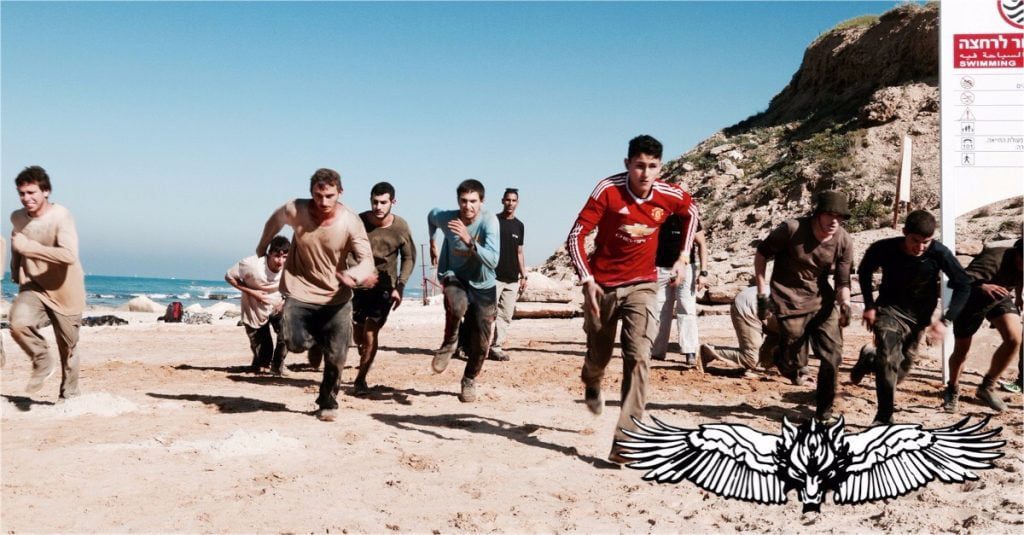
It is hard to simulate full intensity in training because you need to follow safety protocols designed to prevent injuries. Using the best and most advanced protective gear can help you train better. Your training partner is critical to simulating intensity. It is ok to learn a technique without stress, but when you know the technique well enough, it’s time to train it under stress. Your training partner must adopt the role of a real “bad guy” and simulate his attack with enough speed, power, unpredictability, and resistance. Contrary to popular belief, your partner is not doing you any favors by attacking gently and letting you win easily. He needs to make the attack “dirty” in order for you to benefit from it. For example, when attacking you with a knife, he must simulate several thrusts at high speed and try to free his arm when you try to control it. When choking or grabbing, he must try to surprise you and apply real resistance to simulate real stress. When training two attackers against one, one attacker often waits for the other to finish his or her attack. When simulating reality, you cannot wait. You must put constant pressure on your training partner in order to challenge him correctly. Remember—in real life, you won’t be attacked by an old lady with osteoporosis. You will be attacked by a psychotic, blood thirsty beast in his prime. To make training efficient, you must attack with speed, surprise, intensity, and resistance.
Surprise and Fatigue
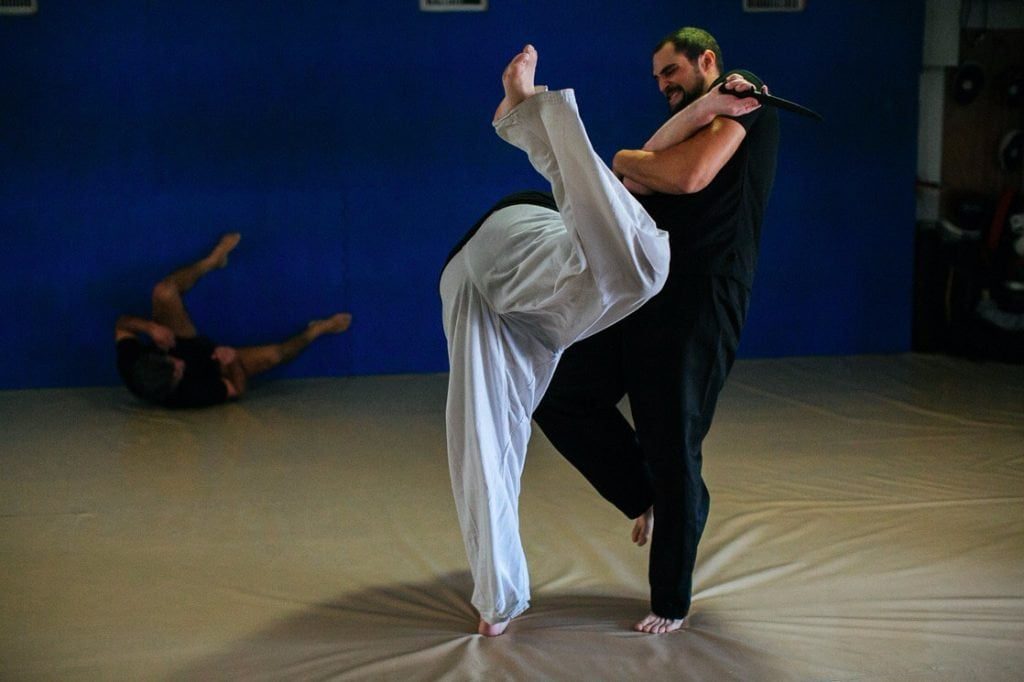
Including a surprise element in drills is especially important because, in real life, the enemy will have free choice of time, place, and form of attack. You will most likely be reacting to whatever the attacker dictates. To simulate surprise, common training tools include shutting the eyes before an attack, using a wall or other cover to conceal the attacker, introducing unknown adversaries, and so on.
Simulating surprise is essential to simulating the physiological responses that result from extreme stress, such as sensory deprivation and decreased mental clarity. The most commonly used element in training scenarios is increasing the heart rate through physical exercise to induce fatigue. This produces a condition similar to that which occurs during stress.
Some other techniques for inducing stress during a training scenario include the following:
Building up to an event or a test (expectation).
Being watched by other people or a crowd.
Operating under time constraints.
Introducing fear of pain or punishment.
Inducing fatigue.
CHOOSING A SYSTEM
“Everybody has a plan until they get punched in the mouth.” —Mike Tyson
You need to train Krav Maga or a similar self-defense system to learn aggression and survival mindsets, defense against weapons, and other complex techniques. You also need to train traditional striking-based and grappling-based martial arts to effectively defend yourself. You may know a technique for every single situation, but under the stress of real life, this will not suffice.
Today, there is a major issue in commercial self-defense gyms because they do not provide effective striking or grappling training. This is the result of both clientele looking for quick fixes and trainers without the appropriate martial arts backgrounds.
There are no shortcuts. Striking and grappling are absolutely necessary because they form the base of most street altercations. You need to become good at striking and grappling in order to handle the intensity of a crazed attacker blitzing you with punches, kicks, or takedown attempts. You need to know how to grapple your way out of situations on the ground in order to survive. Being on the ground is a tactical handicap because there may be more than one attacker and awareness and movement are limited. Commercial Krav Maga and other self-defense systems today do not always teaching striking and grappling in an effective manner. As a result, it is a good idea to train traditional martial arts in addition to specific self-defense techniques. Learn correct stand up technique such as boxing, Dutch kickboxing, Muay Thai, and Kyokushin karate. You should also learn grappling and ground work with styles like sambo, judo, wrestling, and Brazilian jiu jitsu.
My martial arts/self-defense training recommendation includes the following:
Sign up for an MMA gym and attend one or two sessions per week.
Sign up for Krav Maga or another technical defensive system and train there at least once a week.
CHOOSING A DOJO
“They speak of ‘This Dojo’ and ‘That Dojo.’ They are looking for profit.” – Miyamoto Musashi
First, you need a gym with the right values. Usually, this starts with RESPECT. Respect for you, for trainers, for country, for law enforcement, and for other techniques and schools. You need a gym that eliminates EGO. A gym where people show up to train and become better people together—not to injure each other or to show off. You need a place that will challenge you and make you harder to kill. Your body will hurt; your hands, legs, bones, and body need to be conditioned. This hurts, but you will become stronger from it and get used to it. Your hands need to become hard like rocks, like the hands of an expert Kyokushin karate fighter. Your shins, elbows, and knees need to become dangerous weapons, like those of a Muay Thai fighter. Your body and head need to become resilient to impact like those of a professional boxer. You need to become a tougher human being. If you are not sweating or feeling sore afterward, then you are not training efficiently. Spar regularly with people who are slightly less skilled or who are similar to your level in order to improve, but challenge yourself with better people on a regular basis, too.
Commit to the way of the warrior; there are no shortcuts.
Bernardo C. has served as an active member of Israel’s military and law enforcement establishment for almost 15 years. He served in various units of Israel’s infantry and special forces, elite dignitary protection, and federal airline security. In recent years, Bernardo has served as a senior tactical and hand-to-hand combat instructor for Israel’s special operations forces and federal protection services. He holds a graduate degree in counter terrorism and homeland security from the Interdisciplinary Center in Herzliya, Israel, and is the founder and CEO of Tsevet Lohamim (Team of Warriors), a nonprofit leadership training organization dedicated to preparing future soldiers to serve in elite units. Bernardo has extensive martial arts and self-defense training experience in Muay Thai, kickboxing, Krav Maga, and women’s self-defense.
If you have any questions or comments, feel free to contact me at [email protected]
